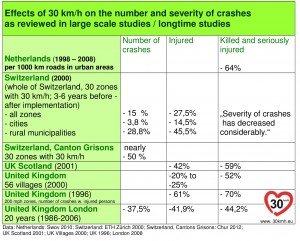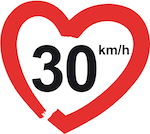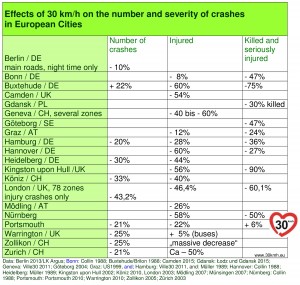How road safety in European cities is increasing, thanks to 30 km/h (20mph)
on Dec 7, 2015

The number of road crashes and casualties in Europe has been decreasing over the years, but the problem is still alarming.
But what if your city had 50 per cent less road crashes, 90 per cent less killed or severely injured, and 50 per cent less children killed or severely injured on its roads? And twice as many children who are allowed to play out because their parents consider the roads to be safe? A fairy tale? No, there are real success stories behind these figures. When we did some research on TRENDSETTER cities for 30 km/h… we found that amazing progress has been achieved in several cities or even countries, through just one measure: 30 km/h (or 20mph) speed limits:
– 50% road crashes, achieved in Switzerland,
– 90% killed or severely injured, achieved in Kingston upon Hull
– 50% children killed or severely injured, achieved in London
+ 35% children allowed to play on the road, achieved in Edinburgh
These are our favourite examples but they are not unique. We found many cities with considerable progress after introducing 30 km/h zones or roads. Our research is still ongoing and here are a few results concerning road safety.
We found some comprehensive studies covering a number of municipalities or a long period of time. They clearly suggest that 30 km/h zones and limits can help. Road crashes are decreasing because of 30 km/h speed limits, in both the number of crashes and the severity of injuries. An overviwe on some major reviews and longterm studies:
A number of cities organised own studies. They confirm the evidence, but are also covering interesting new aspects.
Both tables show a major overall decrease in the number of collisions after a speed limit has been lowered to 30 km/h (20mph).
Concerning the severity of casualties, an impressive fall in the numbers of killed or severely injured victims can be observed as the risk to be severely hit has dropped as well. These results match the fact that 30 km/h speed limits show particularly strong effects on the top speeds, even where average speeds dropped but little. Higher speeds mean greater risks as they have a stronger physical impact where collisions happen.
The tables above can also reveal some local special effects:
Kingston upon Hull managed to get even 90% less persons killed or seriously injured in a crash. This is an amazing effect.
Buxtehude, the German city where the very first 30 km/h zone ever was implemented in 1983, experienced some surprising results: 22 per cent more crashes during the first year! But at the same time, the number of injuries decreased.

